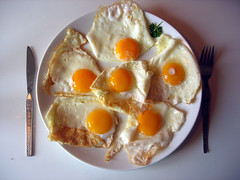A couple of new studies that again question the value of supplements:Effect of Glucosamine Sulfate on Hip Osteoarthritis - glucosamine sulfate is widely used by patients to treat osteoarthritis, despite inconclusive evidence of any benefit.
The abstract is available
hereBackground: The effectiveness of glucosamine sulfate as a symptom and disease modifier for osteoarthritis is still under debate.
Objective: To assess whether glucosamine sulfate has an effect on the symptoms and structural progression of hip osteoarthritis during 2 years of treatment.
Design: Randomized, controlled trial.
Setting: Primary care in the Netherlands.
Patients: 222 patients with hip osteoarthritis who were recruited by their general practitioner. Patients were eligible if they met the American College of Rheumatology clinical criteria for hip osteoarthritis.
Intervention: 2 years of treatment with 1500 mg of oral glucosamine sulfate or placebo once daily.
Measurements: Primary outcome measures were Western Ontario and McMaster Universities (WOMAC) pain and function subscales over 24 months and joint space narrowing after 24 months. The main secondary outcome measures were WOMAC pain, function, and stiffness after 3, 12, and 24 months.
Results: At baseline, both groups were similar in demographic and clinical variables. Overall, WOMAC pain did not differ (mean difference [glucosamine sulfate minus placebo], –1.54 [95% CI, –5.43 to 2.36]), nor did WOMAC function (mean difference, –2.01 [CI, –5.38 to 1.36]). Joint space narrowing also did not differ after 24 months (mean difference, –0.029 [CI, –0.122 to 0.064]). Only 1 of the sensitivity analyses, based on extreme assumptions regarding missing assessments due to total hip replacement, provided results consistent with a glucosamine effect.
Limitations: Twenty patients had total hip replacement during the trial. Half of the patients had a Kellgren and Lawrence score of 1.
Conclusion: Glucosamine sulfate was no better than placebo in reducing symptoms and progression of hip osteoarthritis.Then there is this one which looks at the
Effect of carbohydrate-protein supplement timing on acute exercise-induced muscle damageThe full paper is available
herePurpose: To determine if timing of a supplement would have an effect on muscle damage, function and soreness.
MethodsTwenty-seven untrained men (21+/-3 yrs) were given a supplement before or after exercise. Subjects were randomly assigned to a pre exercise (n=9), received carbohydrate/protein drink before exercise and placebo after, a post exercise (n=9), received placebo before exercise and carbohydrate/protein drink after, or a control group (n=9), received placebo before and after exercise. Subjects performed 50 eccentric quadriceps contractions on an isokinetic dynamometer. Tests for creatine kinase (CK), maximal voluntary contraction (MVC) and muscle soreness were recorded before exercise and at six, 24, 48, 72, and 96h post exercise. Repeated measures ANOVA were used to analyze data.
ResultsThere were no group by time interactions however, CK significantly increased for all groups when compared to pre exercise (101+/-43U/L) reaching a peak at 48h (661+/-1178U/L). MVC was significantly reduced at 6h by 31.4+/-14.0%. Muscle soreness was also significantly increased from pre exercise peaking at 48h.
ConclusionsEccentric exercise caused significant muscle damage, loss of strength, and soreness;
however timing of ingestion of carbohydrate/protein supplement had no effect.
Again, you have to question what is really useful and what is just the latest subject of an advertising campaign....













